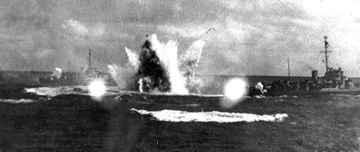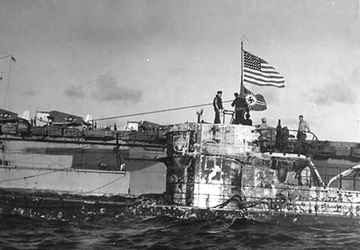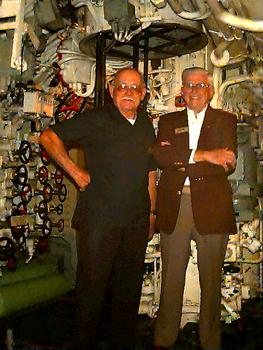In Memorium
As DESA webmaster, I received the following email dated 29 May, 2002. It is with great sorrow that I post this information:
It is with sadness that I report the death of
Rear Admiral George W. Cassleman (Ret) who as a lieutenant commanded the USS Pillsbury
(DE-133) during the historic capture of the German submarine U-505 in 1945. A recent film
dramatized this event. He had been living in Arcadia, CA and died on May 22 of pneumonia
at the age of 91. He was a childhood and lifelong friend of my father. His hearty laugh
will always live in my memory. I attended a rosary for him last night and gave him a smart
salute for all his shipmates.
Robert Huber (FT-3)
USS Kawishiwi (AO-146), 1966-68, Vietnam
RobinCH@aol.com
USS Pillsbury DE-133, USS Pope DE-134, USS
Flaherty DE-135,
USS Chatelain DE-149, and USS Jenks DE-665
Task Group 22.3

Ships from the USS Guadalcanal task group attacking the U-505
with depth charges shortly before capturing the submarine.
(The surface ships are probably the USS Chatelain and the USS Pillsbury)
More photos below
Capture of U-505
On 4 June 1944, hunter-killer group 22.3 of the United States Navy captured the German submarine U-505. This event marked the first time a U.S. Navy vessel had captured an enemy vessel at sea since the nineteenth century. The action took place in the Atlantic Ocean, in Latitude 21-30N, Longitude 19-20W, about 150 miles off the coast of Rio De Oro, Africa. The American force was commanded by Captain Daniel V. Gallery, USN, and comprised the escort Carrier Guadalcanal (CVE-60) and five escort vessels under Commander Frederick S. Hall, USN: Pillsbury (DE-133) Pope DE-134), Flaherty (DE-135), Chatelain (DE-149), and Jenks (DE-665).Alerted by American cryptanalysts, who--along with the British--had been decrypting the German naval code, the Guadalcanal task group knew U-boats were operating off the African coast near Cape Verde.
They did not know the precise location, however, because the exact coordinates (latitude and longitude) in the message were encoded separately before being enciphered for transmission. By adding this regional information together with high-frequency direction finding fixes (HF/DF)--which tracked U-boats by radio transmissions--and air and surface reconnaissance, the Allies could narrow down a U-boat's location to a small area. The Guadalcanal task group intended to use all these methods to find and capture the next U-boat they encountered through the use of trained boarding parties.
The task group sailed from Norfolk, Virginia, on 15 May 1944 for an anti-submarine patrol near the Canary Islands. For two weeks they searched unsuccessfully, even steaming as far south as Freetown, Sierra Leone, in a vain effort to locate a U-boat. On Sunday, 4 June 1944, with fuel running low, the warships' reluctantly turned north and headed for Casablanca. Ironically, not ten minutes later at 1109 that morning, USS Chatelain (DE-149), Lieutenant Commander Dudley S. Knox, USNR, made sonar contact on an object just 800 yards away on her starboard bow. Guadalcanal immediately swung clear at top speed, desperately trying to avoid getting in the way, as Chatelain and the other escorts closed the position.
In the minutes required to identify the contact definitely as a submarine, however, Chatalain closed too rapidly and could not attack--as her depth charges would not sink fast enough to intercept the U-boat. The escort held her fire instead, opened range and setup a deliberate attack with her "hedgehog" (ahead-thrown depth charges which explode on contact only) battery. Regaining sonar contact after a momentary loss due to the short range, Chatelain passed beyond the submarine and swung around toward it to make a second attack with depth charges.
As the ship heeled over in her tight turn, one of two General Motors FM-2 "Wildcat" fighter planes launched overhead by Guadalcanal, sighted the submerged U-boat and dived on it, firing into the water to mark the submarine's position. Chatelain steadied up on her sound bearing and moved in for the kill. A full pattern of depth charges set for a shallow target splashed into the water around the U-boat. As their detonations threw geysers of spray into the air, a large oil slick spread on the water; the fighter plane overhead radioed "You struck oil! Sub is surfacing!" Just six and one-half minutes after Chatelain's first attack, U-505 broke the surface with its rudder jammed, lights and electrical machinery out, and water coming in.
As the submarine broached only 700 yards from Chatelain, the escort opened fire with all automatic weapons that would bear and swept the U-boat's decks. Pillsbury, Lieutenant George W. Casselman, USNR, and Jenks, Lieutenant Commander Julius F. Way, USN, farther away, and the two "Wildcats" overhead all joined the shooting and added to the intense barrage. Wounded in the torrent of fire and believing that his submarine had been mortally damaged by Chatelain's depth charges, the commanding officer of U-505 quickly ordered his crew to abandon ship. So quickly was this command obeyed that scuttling measures were left incomplete and the submarine's engines continued to run.
The jammed rudder caused the partially-submerged U-505
to circle to the right at a speed near seven knots. Seeing the U-boat turning toward him,
the commanding officer of Chatelain ordered a single torpedo fired at the submarine in
order to forestall what appeared to be a similar attack on himself. The torpedo passed
ahead of U-505, which by now appeared to be completely abandoned. About two minutes later,
the escort division commander ordered cease fire and called away Pillsbury's boarding
party.
While Chatelain and Jenks picked up survivors, Pillsbury sent its motor whaleboat to the
circling submarine where Lieutenant (junior grade) Albert L. David, USN, led the eight-man
party on board. Despite the probability of U-505 sinking or blowing up at any minute and
not knowing what form of resistance they might meet below, David and his men clambered up
the conning tower and then down the hatches into the boat itself. After a quick
examination proved the U-boat was completely deserted (except for one dead man on deck -
the only fatality of the action), the boarders set about bundling up charts, code books,
and papers, disconnecting demolition charges, closing valves, and plugging leaks. By the
time the flood of water had been stopped, the U-boat was low in the water and down by the
stern.
Meanwhile, Pillsbury twice went alongside the turning
submarine to put over tow lines and each time the escort's side was pierced by the
U-boats' bow plane. Finally, with three compartments flooded, she was forced to haul clear
to attend to her own damage. The boarding party was then reinforced by a party from
Guadalcanal. Led by Commander Earl Trosino, USNR, the carrier's men completed temporary
salvage measures, and took a towline from Guadalcanal. The salvage crew was later joined
by Commander Colby G. Rucker, USN, who arrived with the seaplane tender Humbolt (AVP-21).
In an ingenious solution to the heavy flooding, the salvage crew disconnected the boat's
diesels from her motors. This allowed the propellers to turn the shafts while under tow.
After setting the main switches to charge the batteries, Guadalcanal towed the U-boat at
high speed, turning the electric motors over which recharged the boat's batteries. With
power restored, the salvage crew could use the U-boat's own pumps and air compressors to
finish pumping out seawater and bring her up to full surface trim.
After three days of towing, Guadalcanal was relieved of her burden by the fleet tug Abnaki
(ATF-96). Arriving with the tug was the tanker Kennebec (AO-36), sent to provide
much-needed fuel to the hunter-killer group. On Monday, 19 June 1944, U-505 was brought
into Port Royal Bay, Bermuda, after a tow of 1,700 miles.**
Fifty-eight prisoners had been taken from the water during the action. One man had been
killed and three (the commanding officer, executive officer, and one enlisted man of the
U-boat) wounded. For his part in saving the abandoned submarine, Lieutenant (jg) David was
awarded the Medal of Honor; Torpedoman's Mate Third Class A. Knispel and
Radioman Second Class S. E. Wdowiak, each received the Navy Cross; and
Commander Trosino received the Legion of Merit.
Task Group 22.3 was awarded the Presidential Unit Citation, in part
because of the unique and difficult feat of boarding and capturing an enemy warship on the
high-seas--something the U.S. Navy had not accomplished since the 19th-century. More
significantly, however, the capture of codebooks on U-505 allowed American cryptanalysts
to occasionally break the special "coordinate" code in enciphered German
messages and determine more precise locations for U- boat operating areas. In addition to
vectoring in hunter-killer task groups on these locations, these coordinates enabled
Allied convoy commanders to route shipping away from known U-boat locations, greatly
inhibiting the effectiveness of German submarine patrols.
Below, read the Task Group Citation and David's Medal of Honor Citation.
David J. Woodland TM2, USS Lawrence C. Taylor DE 415,
submitted the following information concerning the disposition of U-505. While some
accounts state U-505 remained in Bermuda until the end of WW II, Mr. Woodland states this
is not so. DE 415 ship's log verifies his information.
"We towed the U-505 from Bermuda to Portsmouth Navy Yard, NH, June 1944, after all
investigations were completed in Bermuda. They told us it was Italian and it was a
secret."
Task Group Presidential Unit Citation
Admiral Royal E. Ingersoll, Commander in Chief, U.S. Atlantic Fleet, cited the Task Group
as follows:
"For outstanding performance during anti-submarine operations in the eastern Atlantic
on June 4, 1944, when the Task group attacked, boarded and captured the German submarine
U- 505."
"Setting out on an anti-submarine sweep with the stated purpose of capturing and
bringing back to the United States a German submarine, all units of the Task Group worked
incessantly throughout the cruise to prepare themselves for the accomplishment of this
exceedingly difficult purpose. Locating a single U-boat after a long period of fruitless
searches, the entire Task Group participated in intensive search and hold down operations
which terminated in the sighting of the submerged submarine by an airplane. An extremely
accurate initial depth charge attack by the USS Chatelain forced the U-boat to surface
where it was subjected to the combined automatic weapons fire of three destroyer escorts
and two aircraft. This anti-personnel attack completely
achieved its pre-conceived objective in forcing the entire enemy crew to abandon ship
while inflicting relatively minor material damage on the submarine."
"Completely unmindful of the dangers involved all units of the Task Group then
proceeded to carry out their assigned duties in accomplishing the actual capture. The USS
Pillsbury, badly damaged in a series of attempts to go alongside the erratically
maneuvering submarine in order to transfer a mass boarding and repair party, was forced to
withdraw and to transfer necessary personnel by small boat. Undeterred by the apparent
sinking condition of the U-boat, the danger of explosions of demolition and scuttling
charges , and the probability of enemy gunfire, the small boarding party plunged through
the conning tower hatch, did everything in its power to keep the submarine afloat and
removed valuable papers and documents. Succeeding, and more fully equipped, salvage
parties, faced with dangers similar to those which confronted the first group to enter the
submarine, performed seemingly impossible tasks in keeping the U-boat afloat until it
could be taken in tow by the USS Guadalcanal. After three days of ceaseless labor the
captured U-boat was seaworthy and able to withstand, with constant care, the vigors of a
twenty-four hundred mile tow to its destination."
"The Task Group's brilliant achievement in disabling, capturing, and towing to a
United States base a modern enemy man-of-war taken in combat on the high seas is a feat
unprecedented in individual and group bravery, execution, and accomplishment in the Naval
History of the United States."
Medal of Honor Citation
Lieutenant Albert Leroy David, USN
Lieutenant, Junior Grade, U.S. Navy. Born: 18 July 1902, Maryville, Mo. Accredited to:
Missouri. Other Navy award: Navy Cross with gold star.
Citation: For conspicuous gallantry and intrepidity at the risk of his life above and
beyond the call of duty while attached to the U.S.S. Pillsbury during the capture of an
enemy German submarine off French West Africa, 4 June 1944. Taking a vigorous part in the
skillfully coordinated attack on the German U-505 which climaxed a prolonged search by the
Task Group, Lt. (then Lt. j.g.) David boldly led a party from the Pillsbury in boarding
the hostile submarine as it circled erratically at 5 or 6 knots on the surface.
Fully aware that the U-boat might momentarily sink or be blown up by exploding demolition and scuttling charges, he braved the added danger of enemy gunfire to plunge through the conning tower hatch and, with his small party, exerted every effort to keep the ship afloat and to assist the succeeding and more fully equipped salvage parties in making the U-505 seaworthy for the long tow across the Atlantic to a U.S. port. By his valiant service during the first successful boarding and capture of an enemy man-o-war on the high seas by the U.S. Navy since 1815, Lt. David contributed materially to the effectiveness of our Battle of the Atlantic and upheld the highest traditions of the U.S. Naval Service.
(*Note - DE/FF 1050 USS ALBERT DAVID was named for Lt. Albert Leroy David)

As the USS Guadalcanal pulls alongside,
sailors from the task group fly the U.S. flag over the captured submarine.
The USS Abnaki, a U.S. Navy fleet tug, met the task group in mid-ocean to complete the tow
to Bermuda. The U-505 was kept there in secrecy until the end of the war.
Disposition of U-505
As the U.S. Navy was far more interested in the advanced engineering design of fast
underwater U-boats--such as the streamlined German Type XXI and XXIII submarines--rather
than the familiar fleet-boat types illustrated by the U-505, the captured submarine was
investigated by Navy intelligence and engineering officers during 1945 and then promptly
slated for disposal. The intention was to use the hulk for gunnery and torpedo target
practice, a fate similar to those of many other captured enemy submarines.
In 1946, however, Father John Gallery learned of this plan from his brother (then Admiral
Daniel Gallery) and called the Chicago Museum of Science and Industry (MSI) President
Lenox Lohr to see if MSI would have an interest in saving U-505. The museum, established
by Chicago businessman Julius Rosenwald as a center for "industrial
enlightenment" and public science education, specialized in interactive exhibits, not
just view displays and artifacts. Lohr immediately revealed 10-year old plans to include a
submarine in the exhibits of the museum and began a plan to bring the U-505 to Chicago.
The people of Chicago raised $250,000 to help prepare the boat for the tow and
installation at the museum. In September 1954, U-505 was donated to Chicago at no cost to
the U.S. Government. On September 25, 1954 U-505 was dedicated as a war memorial and as a
permanent exhibit. In 1989, the U-505--as the only Type IX-C boat still in existence--was
designated a National Historic Landmark.
Visit the U-505 at the Museum of Science and Industry web site and plan a trip to the museum!

Some of the crewmen from the US Navy Hunter-Killer group 22.3 and the
U-505 occasionally visit the Museum for special events. Above, Zenon Lukosius (left) and
Wayne Pickels, two of the eight men in the boarding party from the USS Pillsbury that
captured the U-505. Lukosius, the man who found the sea strainer inlet cover and stopped
the leak, was 26 years old; Pickels was 21.
Be sure to visit the website of Frank P. DeNardo. Former Signalman 2/C aboard the USS Chatelain - Capture of the U-505 A First Person Account
For more information about the capture of U-505, visit the U-505 Museum website.
Also, records are available at the Navy Historical
Center. The following rolls of microfilm may be purchased by contacting the Center.
Microfilm reel NRS 202 for Task Group 22.3 report of 19 June 1944 which contains the
reports of the participating ships and aircraft; USS Guadalcanal, Escort Division FOUR,
USS Chatelain, USS Pillsbury, USS Pope, USS Flaherty, USS Jenks, and Composite Squadron
EIGHT (VC-8).
Microfilm reel NRS 1974-35 for papers taken from U-505.
Operational Archives Branch
Naval Historical Center
805 Kidder Breese St. SE
Washington Navy Yard, DC 20374-5060
Photos and Information courtesy of: US Navy and the Museum of Science and Industry
![]()
Last Updated: June 10, 2002
copyright © 2000, 2001, 2002 desausa.org
P.O. Box 3448
Deland, FL 32721
(386) 738-6900
fax: (386) 738-2299
